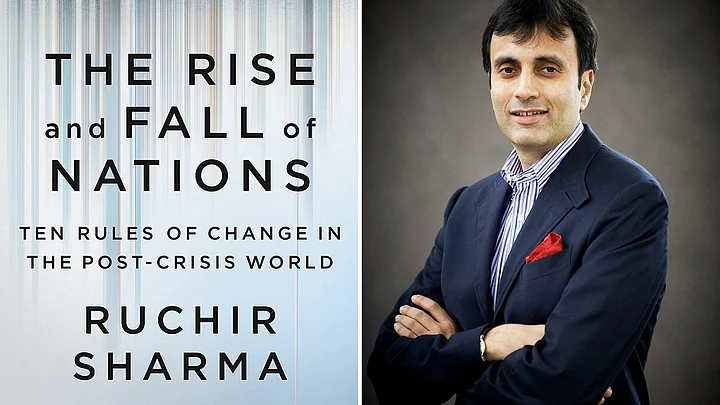Ruchir Sharma’s latest book, The Rise and Fall of Nations: The Rules of Change in a Post-Crisis World, is a tome.
Sharma’s previous book was about emerging economies or “breakout nations” as he called them. But Rise and Fall, which focuses on economies on a global scale, is a guide for “practical people” – forecasters, investors, businessmen and commentators – for them to figure out how the world has changed since the 2008 financial crisis.
- Author: Ruchir Sharma
- Pages: 464
- Publisher: Penguin, UK
- Price: Rs 589 (on Flipkart)
Taking recourse to a clever usage of two globally recognised dating systems, Sharma divides the years into Before Crisis (BC) and After Crisis (AC), while employing his team of researchers to perform extensive data analysis, crystalising their findings into ten variables/indicators which need to be studied to judge the prospects of any economy five to ten years in the future.
The overarching theme of Rise and Fall is that impermanence is the rule and economic booms, even though they may seem permanent, do end. Indeed, the longer a boom period lasts, the more people begin to believe that it will continue to last.
However, the probability that economic booms will end also increases. The same holds true for depressions. The trick is to detect tell-tale signs of forthcoming change.
Sharma’s ten indicators get a chapter each – demography, scope for reform, inequality, quality of government regulations, geographical location as a source for trade, investment, especially in manufacturing, inflation, high rates of exchange (expensive country) or too low (inexpensive country), the rate of change in the debt-GDP ratio and the media hype that a country receives.
Each chapter illustrates the relevance of the specific indicator by citing data from across the world.
In some cases, there are precise quantitative guides. Is the population growth rate around 2 percent? Both high and low population growth signal danger. Sharma blames the post-2008 economic stagnation in developed countries on demographic stagnation. China too stares at a problem because its population has just begun to shrink.
As for investments, anything between 25 to 35 percent is good. Anything lower than or above this range – as in China which clocked 45 percent– are danger signals. The size of the manufacturing sector is critical. Inequality is a worrying sign, especially if the wealth is obtained through corruption (bad billionaires) rather than enterprise and risk-taking (good billionaires).
Inflation has to be judged relative to any country’s peer group average and/or recent macroeconomic data. Sharma cites India as a case study. The country slipped into double-digit inflation during UPA 2 but the government failed to address it.
Now India has taken the fight against inflation to heart, though the tough stance of Raghuram Rajan has raised heckles. For developed countries a level of 2 percent is ideal while for an emerging economy 5-6 percent may be the norm.
Besides, increase in the debt-GDP ratio – that is, if debt rises faster than income – does not augur well for the economy.
There is also a lot of discussion on politics and the importance of leadership. Sharma believes that leaders start with reforms when they arrive at the top, propelled perhaps by the demand for change. But they often overstay their welcome, and the reform agenda peters off. Putin is a good example.
Sharma’s contention seems to be that no leader should have more than two terms to avoid the Mugabe syndrome.
The quality of government regulation is subjected to a detailed analysis. State Capitalism can become crony in no time. State-owned banks can be taken for a ride by borrowers who have political connections. Governments meddle with private companies or impose restrictions on them.
In this context, Sharma cites the experience of China. The country’s success in the past does not justify Statism, he says. Indeed the slowdown in a China is as much a consequence of mis-governance as anything else. The example of Venezuela where Chavez spent buoyant oil revenues only to spell disaster for his successor Maduro when oil prices collapsed, illustrates how prudent public finance is good for poor and rich countries alike.
The concluding chapter classifies the economies around the world into the Good, the Average and the Ugly using the ten indicators grid. Sharma is bullish about South Asia - Pakistan and Bangladesh as well as India - but has some reservations about the quality of government intervention. China is Ugly, that is, on its way down. Brazil, Canada, Australia, Russia all end up in the Ugly camp as they are at the mercy of the commodity price cycle. They overspend during the price rise and struggle when commodity prices slump.
This is no doubt a big book and even a good book.
My only complaint is that it is too long. Ideally, it should have been only half its present length. The author feels the necessity to cite examples from regions across the world each time he poses a question.
For the busy person, I would advise reading the introduction - Impermanence and the concluding chapter – The Good, the Average and the Ugly thoroughly.That will give you the gist of Ruchir Sharma’s argument. Then flip the pages around, when you have the time, to get the flavour of the rest.
(Meghnad Desai is the author of over 25 books and 200 articles in journals across the world. He is also a British parliamentarian sitting in the House of Lords.)
(At The Quint, we question everything. Play an active role in shaping our journalism by becoming a member today.)
